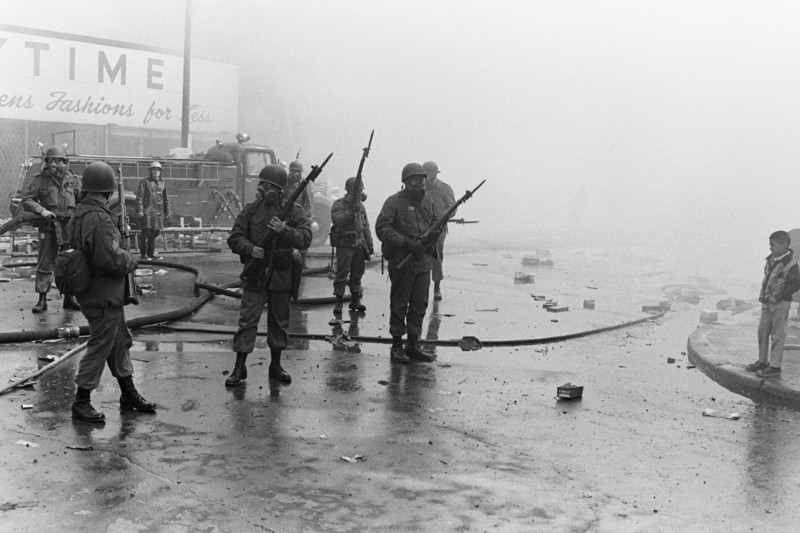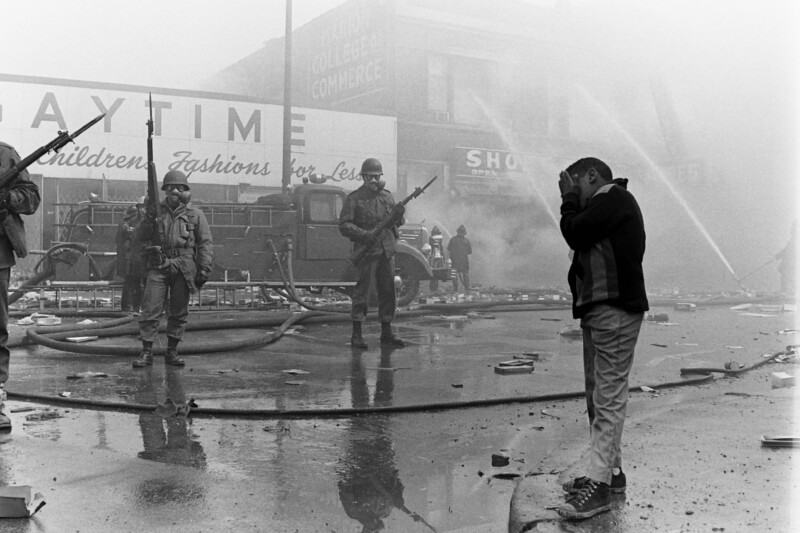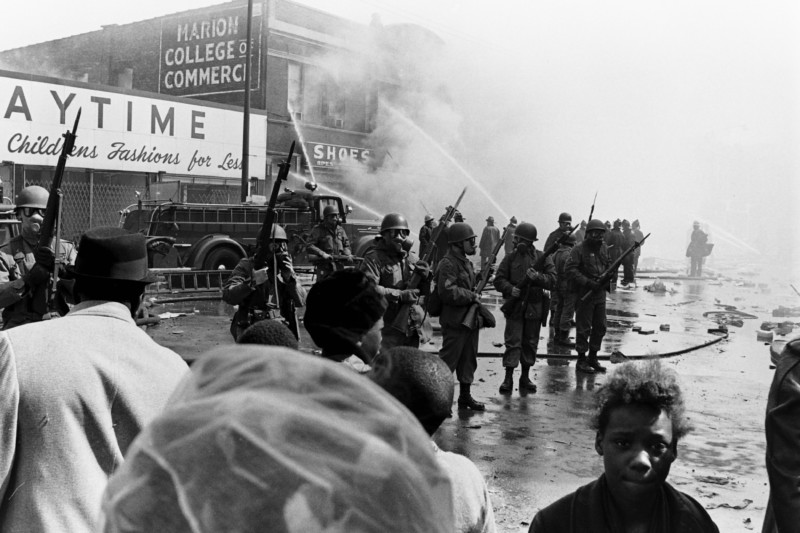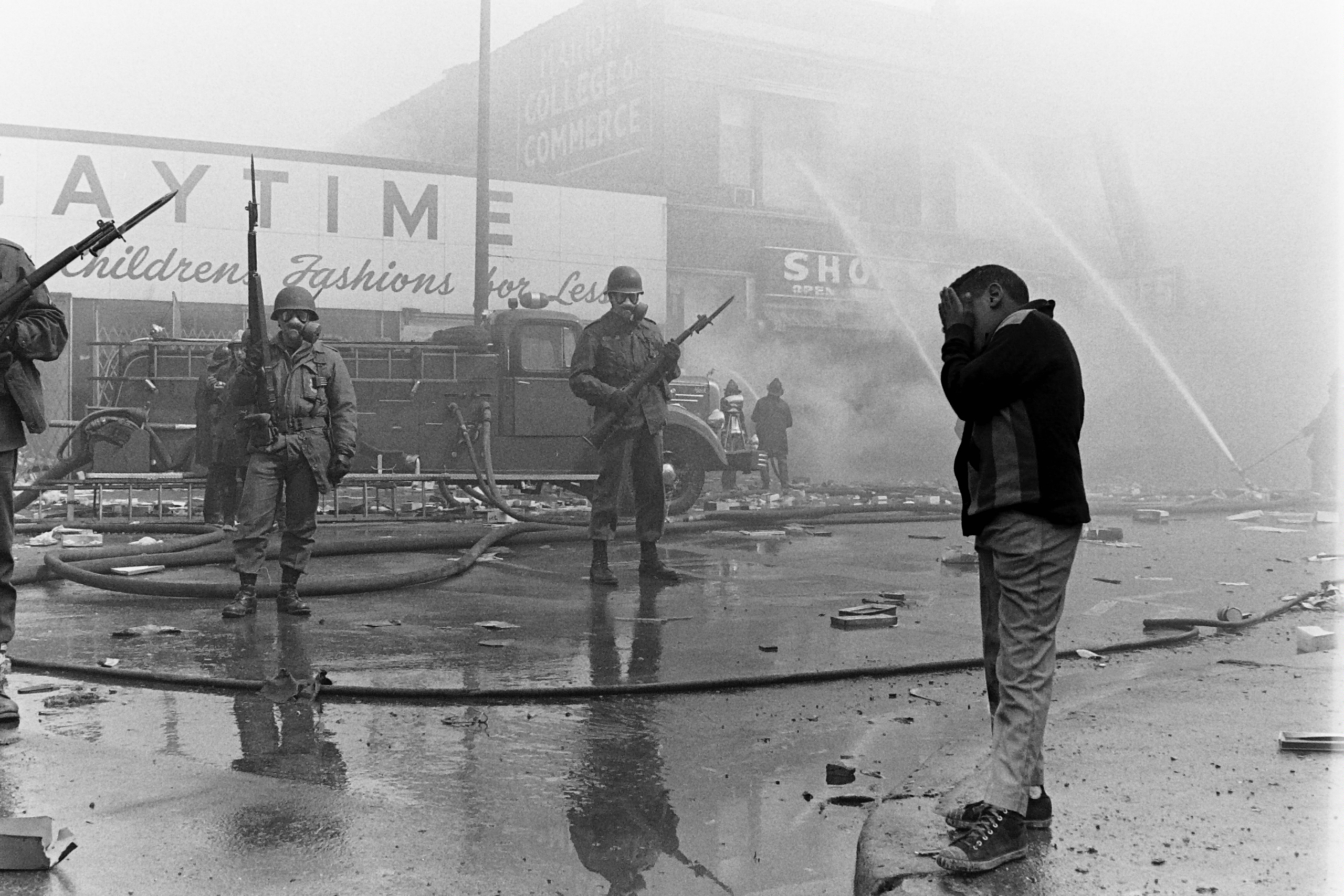Sign up for The Media Today, CJR’s daily newsletter.
DAYS AFTER THE ASSASSINATION of Martin Luther King, Jr., an amateur photographer named Karega Kofi Moyo took his camera to the Lawndale neighborhood of Chicago. At the intersection of Spaulding and West Madison, Moyo photographed a young black boy standing near a group of armed National Guardsmen, their faces hidden by gas masks. In one photo, the boy—whose name remains a mystery to Moyo—covers his face. “Like he’s in distress,” Moyo says.
The photo is one of dozens that Moyo took during the days of looting and violence that engulfed the city after King’s killing. Moyo, who taught science at a nearby school at the time, followed his curiosity and sense of purpose to what Chicago newsrooms called a “riot”—and what journalist Gary Rivlin later described as one of the most traumatic events in the city’s history. The unrest left 11 dead, dozens injured from police gunshots and two miles of charred rubble where a thriving business district once stood.
Moyo developed his negatives in a darkroom at the Chicago Defender, but did not publish the photographs. While Moyo had friends in Chicago’s vibrant black press, he wasn’t part of the journalism world.
ICYMI: Paper rattled by racist cover controversy
Twenty years later, Rivlin wrote in the Chicago Reader that a lack of retrospectives on the April 1968 events—especially compared to anniversary coverage of the city’s 1968 Democratic National Convention—confirmed “the suspicions of a great many Chicagoans about the mainstream white media’s lack of interest in the west side and in the black population in general.”
While journalists scoff and shudder at the suggestion, what can explain the disparity in coverage if not a sort of racial tunnel vision? Though whites actually constitute a minority in Chicago, around 90 percent of the reporters, producers, and editors who shape our news are white. Many of them came of age during the 60s; many were forming their political views at the time of the Democratic Convention, and a few probably went into journalism as a direct result of the events that surrounded it. It would be unfair to fault these journalists for looking back at such a pivotal event in their lives, but one can’t help believing that if there were more blacks in positions of power in the media, some editor would have penciled in his calendar a reminder to commemorate the King riots in this their 20th anniversary year.
Moyo’s photographs are an essential and vivid piece of the story of the April 1968 uprisings. However, with just one exception—a print exhibited in Lagos, Nigeria, as part of the 1977 Second World Black and African Festival of Arts and Culture—the images stayed in a box, and went unseen by the public for nearly 50 years.

Photo from the April 1968 uprising in Chicago. Courtesy of Kofi Moyo.
THIS YEAR, MOYO exhibited five photos from April 1968 in the tiny Rootwork gallery in the Pilsen neighborhood on Chicago’s West Side. The sequence of photos documents Moyo’s chance encounter with the young boy and the National Guardsmen. In one photo, shoeboxes from a nearby store litter the street as the boy surveys the soldiers. Click. In another, the boy brings his hands to his face. Click. After the boy walked away from the guards, Moyo turned his lens to the crowd gathered in front of Harold’s Chicken Shack. A little girl looked at him—expectant, almost urgent—as the soldiers lined up. “There’s a question in her face,” Moyo says. “‘Did you get this?’” Click.
Moyo, who is now 78 years old, went out to photograph the April 1968 events “to see how far I could get,” he tells CJR in a recent interview. “I had no press credentials. I just wandered.”
Tracie Hall, founder and owner of Rootwork, says she spoke with Moyo’s former wife and business partner about his work, and was intrigued that the photographs had never been published. Moyo “was a first-hand witness to the West Side we’ve inherited, how it got to that place, what kinds of circumstances really led to the landscape we’ve inherited,” she says.
ICYMI: Covering protests has become the riskiest job in journalism
The photographs, for Hall, link the West Side’s ongoing struggles with poverty and crime to a critical moment in the city’s history. Before the uprising, the area around the intersection where Moyo photographed the boy was a thriving neighborhood with a busy commercial district. After the fires and the looting, and after the city bulldozed the destruction, it became “a neighborhood completely altered,” Hall says. “That’s why I really left like I needed to show this work.”
Though they are decades old, the photos also now echo contemporary tragedies like the death of Tamir Rice, the 12-year-old boy fatally shot by police in Cleveland in 2014. They could be the images of any black child in American today.
And, both literally and figuratively, Moyo’s photographs depict a historical event through a new lens. “The press, the media, called this a ‘riot,’” says Moyo. “I saw it as a rebellion.”

Photo from the April 1968 uprising in Chicago. Courtesy of Kofi Moyo.
MOYO’S IMAGES COMPLICATE the longstanding narrative about what happened in Chicago in April 1968. Their appearance, decades later, remind viewers that the historical record, which can draw heavily on press coverage, is manmade. They remind us of the moments we don’t see in photographs, and the importance of ensuring and fostering diversity among journalism’s practitioners.
At the request of CJR, Greg Foster-Rice—a Chicago photo historian and an associate professor at Columbia College Chicago—compared Moyo’s photographs with others taken at the time. He pulled out a book from The City Lost and Found, a groundbreaking exhibition in 2014 at the Art Institute of Chicago, co-curated by Foster-Rice, that focused on a pivotal shift in American cities during the 1960s and ’70s.
In the book, Foster-Rice located what appears to be the same boy from Moyo’s images, in a picture by a photographer named Kenneth Lovette. The boy wears the same clothes and shoes as in Moyo’s image. However, in Lovette’s photo, the boy has written the words “black power” in shaving cream on the street. The Chicago Sun-Times published Lovette’s photo on April 7, 1968.
Moyo doesn’t recall the exact date he took his photographs. But Foster-Rice is convinced the boy from Moyo’s pictures is the same person in Lovette’s photo. Moyo’s pictures, then, help to capture a remarkable evolution in the boy, from an apparent distress to what Foster-Rice calls “a certain kind of resistance in the street.”
Richard Cahan, a former picture editor of the Chicago Sun-Times, book author and publisher, says Moyo wasn’t alone in photographing the MLK uprising, but he likely was one of few African-American street photographers documenting reactions at the time.
“It wasn’t something people generally would do,” he says. “People didn’t just wander into the neighborhoods.”
The uprisings were a dangerous place even for photographers with press credentials. “It was kind of tough in the beginning because it was crazy,” says Bob Black, who grew up on Chicago’s South Side and joined the Sun-Times photography staff a month before King’s assassination. “Things were moving all around you. You had to be careful not to be too involved. You were careful not to get in the way of the police and not get too close to the people creating the situation. It was a juggling act.”
Black was injured during the riots after being beaten by police. “It was dangerous,” he recalls. “The cops were, they were very aggressive, over-the-top aggressive. It was tough. You had to be very careful.”

Photo from the April 1968 uprising in Chicago. Courtesy of Kofi Moyo.
THE YEAR AFTER the so-called riots, Moyo joined the University of Chicago press office as a photographer, where he worked for 11 years. With his former wife, Yvette, he went on to start the Real Men Cook, a network of community charity events that share a name with Moyo’s cookbook.
Even though Moyo is not well-known within Chicago’s larger photojournalism community, his work is important, says Romi Crawford, associate professor at the School of the Art Institute of Chicago. She recently has begun to inventory Moyo’s collection, which is stored in her studio.
“It’s an archive that I’m just becoming familiar with,” says Crawford, who hints that there is more to be discovered in Moyo’s previously unseen work. “What I see is remarkable and exciting for what it shows and tells about Chicago’s South Side and African American community from the ’60s and ’70s. What I see so far is a remarkable storytelling of that period of that time in the city.”
ICYMI: Photographer behind graphic Charlottesville image recounts near-death experience
Has America ever needed a media defender more than now? Help us by joining CJR today.



